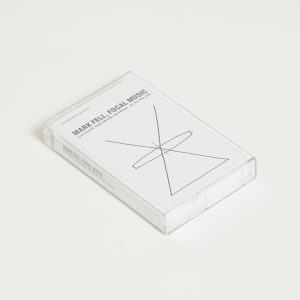after few days spent at ZKM in Karlsruhe, Germany some new works came out.
one of these is a two-part piano piece I recorded following some time-shifting tempo beats Mark were playing to me via headphones.
released through Touch, Tapeworms label
Cassette only – limited edition of 200 copies
Featuring Laura Cannell, Sandro Mussida and Aby Vulliamy
A1: Focal Music #4 with Aby Vulliamy, Viola, Leeds 2015, 11:14
A2: Focal Music #3 with Laura Cannell, Overbowed Violin, Newcastle 2015, 20:41
B1: Focal Music #5a with Sandro Mussida, Piano, Karlsruhe 2016, 15:32
B2: Focal Music #5b with Sandro Mussida, Piano, Karlsruhe 2016, 15:20
Mark Fell writes: “The series of works on this cassette began in 2011 when I attended a workshop/residency programme led by the British sound artist, composer and performer Jan Hendrickse. During a workshop session I played a pattern generating system via headphones to a drummer, Patrik Jarlestam, who played a single snare drum. The basic premise of the work was that the performer should follow the pattern as accurately as possible, and to see what happened at the moments when the pattern changed – i.e. to foreground the performers attempts to follow the pattern and their ability to cope with the subtle yet unusual changes.
The pattern itself consists of a single percussive sound. The timing of the sound is determined by a list of five values ranging from one to 11 that represent timing intervals. These values are stepped through one at a time and multiplied by a base value, typically 80 milliseconds, to give the following possible timing intervals: 80, 160, 240, 320, 400, 480, 560, 640, 720, 800 and 880 milliseconds. A typical pattern might consist of something like 240, 240, 480, 320 and 320 which makes a total loop length of 1.6 seconds. If a single value is changed, for example element one becomes 560, the overall loop length extends to 1.92 seconds.
The pattern itself consists of a single percussive sound. The timing of the sound is determined by a list of five values ranging from one to 11 that represent timing intervals. These values are stepped through one at a time and multiplied by a base value, typically 80 milliseconds, to give the following possible timing intervals: 80, 160, 240, 320, 400, 480, 560, 640, 720, 800 and 880 milliseconds. A typical pattern might consist of something like 240, 240, 480, 320 and 320 which makes a total loop length of 1.6 seconds. If a single value is changed, for example element one becomes 560, the overall loop length extends to 1.92 seconds.
Although the patterns are relatively simple, and as a listener one can assimilate their form quite easily, it can be quite difficult to play along to them especially at those moments of change. So the piece can be thought of as a kind of intervention into the musical training and embedded musical vocabularies that the performer brings to the work. The point of the piece is not a perfect recital, but the difficulties that the performer encounters and the musical moments that these difficulties produce.
Unfortunately I believe there is no recording of Jarlestam’s first performance of this piece – “Focal Music #1”. The piece was performed a second time by Okkyung Lee during her residency at Café Oto, London 2015. “Focal Music #3” was performed with Laura Cannell at Baltic 39 (Newcastle, 2015) for Broken Telephone, an event which formed part of Peter J. Evans’ exhibition Across Islands, Divides. “Focal Music #4” was performed with Aby Vulliamy at The Leeds Library (Leeds, 2015) at Peter Gidal/Mark Fell: Film/Sound organised by Pavilion and curated by Will Rose. “Focal Music #5a” and “Focal Music #5b” were recorded with Sandro Mussida at Zentrum für Kunst und Medientechnologie (Karlsruhe, 2016) in the Kubus studio. The piece, performed on piano, takes two forms: the first based upon a six note pitch set of which any two notes are played at the same time; the second is formed of 5 discreet layers each with a single note. These were played in isolation following the same guide pattern and then later overlaid to form a single pseudo chord.” – Mark Fell, South Yorkshire, 4th May 2016
